|
Nextar I4-BC with Back-Up Camera Review |
30th September 2008 |
|
Review by Lutz Bendlin
 In July Maft has reviewed the Binatone T430, one of the first Personal Navigation Devices with an additional safety feature - a rearview camera. The Binatone serves the european market (featuring iGO2006+), and I was looking for something equivalent for the american market when I saw a Nextar add. The device in the add looked very similar to the Binatone, so I asked for a review unit. I also wanted to see for myself how the back-up camera was integrated into th device
In July Maft has reviewed the Binatone T430, one of the first Personal Navigation Devices with an additional safety feature - a rearview camera. The Binatone serves the european market (featuring iGO2006+), and I was looking for something equivalent for the american market when I saw a Nextar add. The device in the add looked very similar to the Binatone, so I asked for a review unit. I also wanted to see for myself how the back-up camera was integrated into th device
The present review will look at the differences between the two models, but will also look a bit deeper under the hood of the device, and will show you what else you can use it for.
In The Box
The Nextar doesn't come in a box as we know it , rather it is presented in a kind of blister package that is designed for shop displays, and reveals the two main elements - the PND and the camera.

To get to the rest of the components you have to take the blister out of the cover, and then open a white box hidden inside.
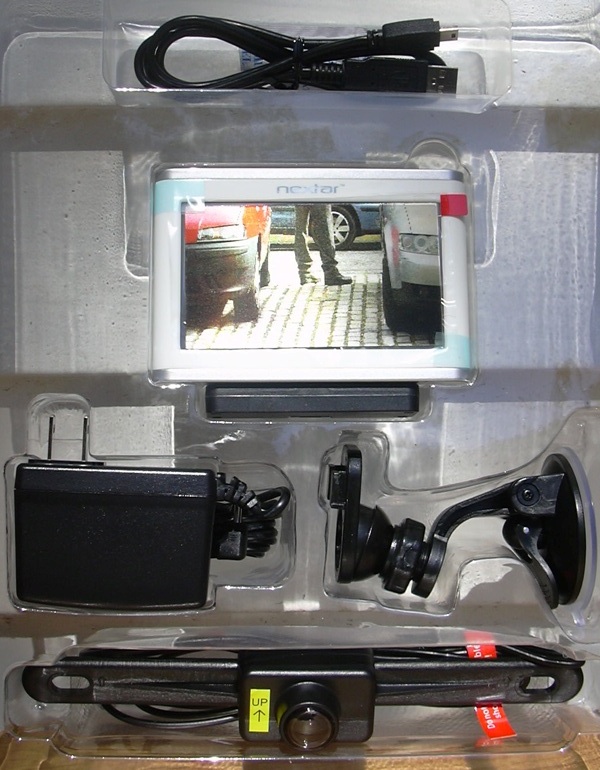

The overall content seemed to to be the same as for the Binatone:
- PND
- (manufacturer) Windscreen mount & PND attachment
- Round plate for dashboard mounting (3M sticky-pad on reverse)
- 12v power adaptor
- Mains adaptor
- USB lead
- Rear-view camera
- Various attachments for rear-view camera
- Carry pouch
- Instruction manual
Device Walkthrough
The table below shows the specifications. Different from the Binatone the Nextar device came with Bluetooth disabled. As you may have seen from Maft's review that is not a big loss since Bluetooth did not work properly on the Binatone anyhow.
Nextar I4-BC
Wide screen PND with wireless rear view camera |
GPS receiver chipset |
Mstar |
SD RAM |
128MB |
Screen size |
4.3" |
Display Resolution |
480 x 272 |
Win CE |
Version 5.0 |
Touch-screen anti-reflective LCD |
Yes, wide-screen |
Built-in Antenna |
Yes |
Built-in Speaker |
Yes |
Batteries |
Rechargeable Li-Polymer battery (1400mAH) |
Batteries usage time |
Up to 3.5 hours |
Car Mounting Kit |
Yes |
In-car charger |
Yes |
Home Plug Power Connector |
No |
USB Cable |
Yes |
Digital Pictures Viewer |
Yes |
Document Viewer |
Yes |
Remote control |
No |
MP3 & MP4 player |
Yes |
|
Dimensions |
117 mm x 80 mm x 19.5 mm |
Weight |
180 g |

The front of the device shows the display (surprise, surprise). The case has a pleasant white/silver theme, a welcome departure from all the black you see on other devices. Let's look at the other sides too.

The top features the soft on/off switch. The back shows the external MMCX antenna connector, the speaker grille, and another on/off switch. However this is the master switch, and similar to a hard reset button. Since some consumers seem to have been confused by the two switches Nextar have added a "Please switch on the GPS device" sticker. This has the potential to confuse even more since it's not just the GPS that you need to switch on - it's the complete PND that won't do a thing unless you flip this switch.
The advantage of such a solution is that you can store the device longer between uses because switching the device off with the slider will really disconnect the battery. If you only use the software on/off at the top then the device will go into standby, and still drain the battery, albeit at a reduced rate.
The black inverted T is the receiver for the camera, doubling as an adapter for the windscreen mount (note the typical Arkon prongs)

On the right side of the device you have the SD card slot, the headphone socket (2.5mm unfortunately) and the power connector. The power plug is slightly smaller than the one normally used in the older GPS devices and Pocket PCs.

On the left side you have the compartment for the stylus. The stylus is retractable, and is certainly usable. It's just not clear if a stylus should be used with a PND - I would think PNDs should exclusively be operated by your fingers.

The bottom sports the USB data port. Surprisingly this port cannot be used for charging, which would point to a rather ancient device design (ie 2005 or earlier) . On the other end is the microphone hole (for the non-existent Bluetooth handsfree functionality). In the middle is the most interesting design element of the PND - the connector for the back-up camera receiver. It reminds me of the connector that you find on notebook batteries, and it should survive a few thousand contact cycles easily.

You've seen the back of the receiver in a picture further above - here's the front with the PCB connectors and the locking mechanism that mates the receiver with the PND.

As seems to happen pretty often I wasn't careful and all of a sudden was looking at the naked PCB.

The antenna seems to work fine. Keep in mind that it doesn't have to cover large distances anyhow. Metallic lift gates (back doors) could be a challenge but on my car that piece is made of plastic, so no issues there.
Installation
The obvious hurdle for installation is fitting the rear-view camera. Different from the european model the backup camera in the Nextar kit is supposed to be placed on top of the licence plate, using the existing two screws. In order to achieve the required downward angle the kit comes with a set of angled washers.
The back-up camera obviously needs to be powered. This means you will need to find a way for the cable to get to the contacts for the standard back-up light of your car. In my case it actually meant drilling a little hole into the liftgate, and completely dismantling the inner side of the liftgate. It took me a good hour to get everything installed and reassembled. Thankfully that's just a one-time effort.

The PND itself can mount onto any Arkon mount. The provided Arkon Windscreen mount is acceptable, but you do really see the quality differences when you compare it to a HR or even Brodit/Proclip mount. Also keep in mind that windscreen mounts are not permitted in a growing number of states.

As Maft mentioned the windscreen setup is further complicated by the fact that the power lead is coiled. This puts unnecessary strain on both the holder and the device. Unfortunately you can't replace the power cord with a straight one as the plug is not standard.
Software
The brains of the Nextar I4-BC navigation engine is Netropa's Inav 4 (hence the device name). We reviewed Inav/Iguidance4 extensively, so I won't go into much detail here. The complete maps for US and Canada are preloaded into the Flash ROM.
One thing that I keep being impressed by is their choice of Text-to-Speech engine (RealSpeak Solo). It just shows that TTS is definitely possible, and working very well, on a Windows CE or Windows Mobile device. I am astonished that many vendors still use prerecorded sounds.
Apart from the navigation program the device also has a music player and a photo viewer. Both of them are rather rudimentary, and I will show you some much better alternatives later on.


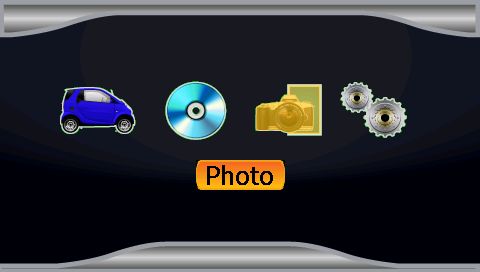








Rear view camera
Besides navigation, the other main selling point of the I4-BC is it's back-up camera (hence the second part of the device name). Following Maft's review I was curious how this is implemented. Turns out that the back-up camera is completely independent from the PND's running programs and even from its operating system (Windows CE5).
Once the camera has power, and the receiver is connected to the Nextar the video from the camera is brute-forced directly into the LCD screen. Instead of whatever is running on the PND you will see the video picture from the camera.
Initially I thought I could do screenshots of the camera function but since the video feed goes directly to the LCD this option is just not available. So I'll repeat Maft's pictures here - my camera worked exactly the same.
What this also means is that your navigation program keeps running while the camera is active. So you could also do voice guided navigation while driving in reverse....
Back-up camera considerations
A while back I had bought that very same back-up camera from Costco in a set, consisting of the camera and a standalone monitor. I thought I could save the install time by using my existing camera with the Nextar. Alas, the radio frequency didn't match properly, and the video would not be stable. It all worked fine with the provided camera. I might have saved the original setup had I found the place where you can tune the transmitter frequency (there is nothing in the receiver that looks tune-able).
When you install the camera make sure it is absolutely watertight (if necessary fill all the cracks with silicone). After a few light showers (by Houston standards) the inside of the protective lens cover started to take on condensation and I actually had to drill a hole at the bottom of the protective cover to give the device a chance to dry out, and to make the camera useful again.
Windows CE
Let's recap the specifications of the device - it has a 4.3" widescreen LCD with a 480x272 resolution. Admittedly not as gorgeous as the iPAQ 310 with 800x480, but still very respectable. In fact this is the same LCD as on the TomTom Widescreen PNDs. What would it take to hack into Windows CE and try to run other navigation programs?
I found the answer on the Nextar support side. They are offering the occasional ROM update, and by looking at that setup I was able to figure out how to get to the Windows CE shell.
All you need to do is to place a autorun.inf text file into the root of the SD card, and in that file specify the path to the program that should be launched when you tap "Navigation" in the main menu.
So for example you can replace
navigation=\Flash_Storage\Netropa Intellinav\Intellinav.exe
with
navigation=\windows\explorer.exe
Alternatively you can point it directly to the program on the SD card that you want to run instead (the SD card slot is called MMC_Storage) . I got various versions of TomTom to run, as well as TCPMP and OziExplorerCE etc. I can recommend TCPMP, it works very nice as a video player to silence the passengers in the back seats.
Here's a collection of screenshots from these tests. Note the "Malata" applicaton - this is the main shell, and brings back fond memories of my Malata DVD player.

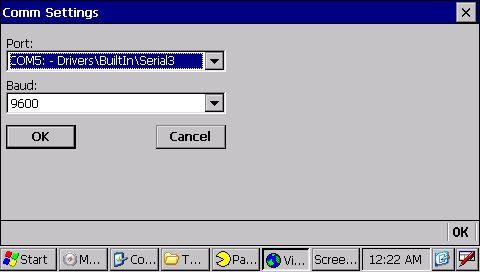
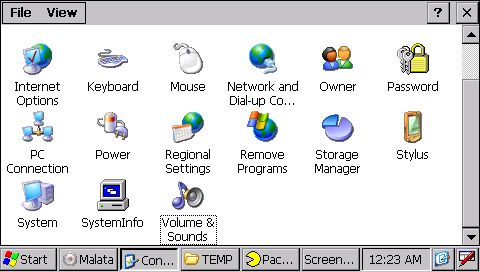






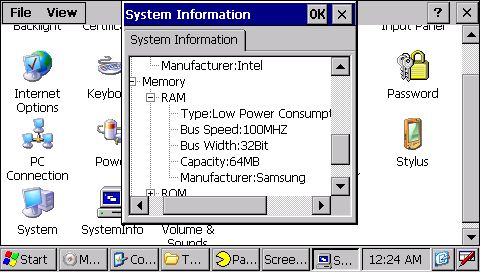





Interesting - the device has a command line console and a version of IE for Windows CE (despite the lack of connectivity - I used ActiveSync for the below, haven't tried a SDIO WiFi card yet)





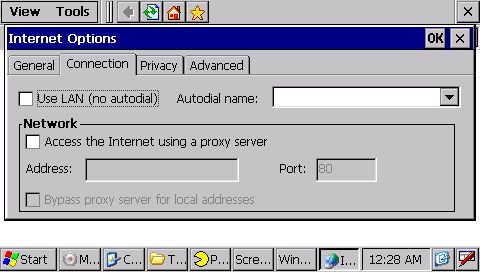


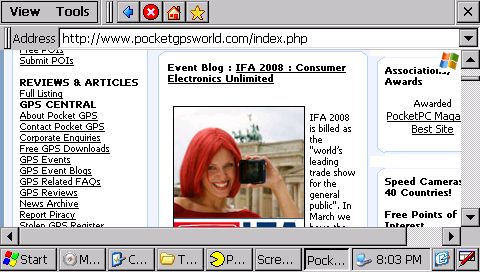
Round Up
Pros
- Uses iNav4 software with TTS
- Good routing (including "convenient")
- Rear-view camera works very well, independent of Windows CE
- Wide Screen
- Easy to run other Windows CE programs
Cons
- Short, coiled power lead pulls too much on sockets
- Internal speaker not really loud enough
- 2.5mm headphone socket rather than more common 3.5mm
- No Custom POIs
- No bluetooth
Conclusion
The Nextar I4-BC delivers on the value-add promise - the back-up camera works very well, and really helps you to judge your environment better when you have to put your car into reverse for whatever reason. At the same time the PND is in no way restricted in its original functionality.
The white and silver front is a pleasant departure from the dull black standard of other devices. A number of design elements are unfortunate, and one would hope that in future versions Nextar would go for more standard connectors and cables.
The widescreen LCD is definitely an advantage over the predominantly QVGA LCDs used by other devices.
References & Links:
References |
|
| Manufacturers Web site |
http://www.nextar.com/ |
| Pocket GPS World Contributor |
Lutz Bendlin |
| Guide Price at time of publication |
$225 (Amazon) |
| |
|
Comments?
Have any comments about this review? Post them here.